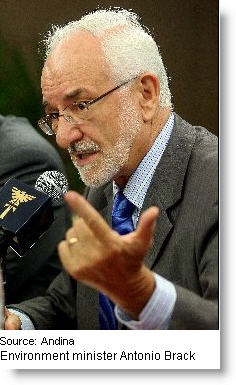Emergency measures to reduce heavy-metal contamination in Peru’s Mantaro River basin and pollution caused by informal mining in the Amazon’s Madre de Dios region are soon to be implemented, said Environment Minister Antonio Brack Egg on Sunday.
 “Our Ministry and seven other ministries are currently designing a strategy to save Madre de Dios from informal mining,” Brack told official state news agency Andina. “The problem is like a cancer, because as the price of gold increases, so does informal mining.”
“Our Ministry and seven other ministries are currently designing a strategy to save Madre de Dios from informal mining,” Brack told official state news agency Andina. “The problem is like a cancer, because as the price of gold increases, so does informal mining.”
According to Brack, gold prospecting by an estimated 120,000 informal miners across Peru generates approximately 36,000 kilograms of mercury contamination of waterways, poisoning fish — the main staple of indigenous communities and coastal cities and towns.
“The issue is deteriorating in Madre de Dios, because of the serious problems (informal mining) generates, such as as prostitution, slavery, labor rights violations and, especially, environmental contamination,” added Brack.
Tailings from more than 30,000 small-scale miners are also causing widespread environmental damage in Lake Titicaca, the largest lake in South America and the highest commercially navigable lake in the world, and in Lake Chinchaycocha, Peru’s second largest lake.
In Peru’s highlands, several lakes and rivers are also polluted by tailings and mercury, a substance often used by informal miners. Liquid mercury is used to amalgamate the gold, both at the site of extraction and later in shops or in homes where gold is boiled with mercury to form larger nuggets to sell to urban gold traders.
According to a recent study, the Mantaro River, which is one of the main sources of irrigation water and electric power in the fertile Mantaro river basin, or the breadbasket of Peru, carries in its headwaters 12.3 tons of copper, 313 tons of steel, 11.8 tons of lead and 9.9 tons of arsenic every year.
Small-scale mining poses a complicated problem for Peru because of its social, political and economic nature. Any solutions to the negative consequences it generates must take into account the sanitary and environmental impacts of poverty, the needs of small-scale miners and their families, the ability of Peruvian authorities to monitor and enforce regulations, and the fact that large mines often compete with small-scale miners for access to mineral deposits and land.
For poor people, the struggle to survive often takes precedence over protecting the environment. Informal gold miners, often from poor migrant communities, are lured to Madre de Dios by the dream of easy riches. The department is the most active alluvial gold mining region in Peru, producing between 50 and 100 tons of gold annually.
Unfortunately, reports the Amazon Conservation Association, “that gold rarely enriches the artisanal gold-mining communities, who are sometimes entrapped by mounting debt for equipment, loans, and concession rentals. Instead, they find themselves locked in an endless cycle of deforestation, mercury poisoning, and poverty.”





